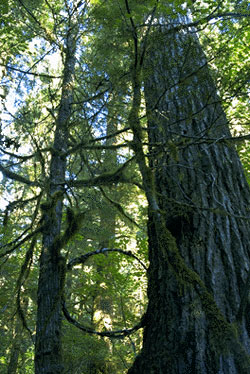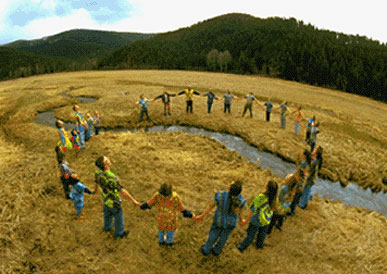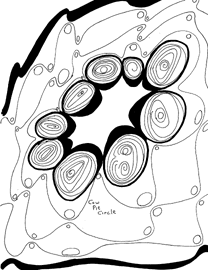
Gifford Pinchot National Forest


Long been referred to as the "Sacrifice Forest" of the National Forest system, the GPNF is heavily fragmented and has a high road density. Though the President's Forest Plan protected some good old-growth habitat in the Late Successional Reserves (LSRs), the GP still lives up to its unfortunate label. The matrix (the area managed for timber harvest) in the GPNF, houses more spotted owl pairs and old-growth forest than does the LSRs. In addition, belying any notion of ecosystem management, the current timber plan on the GP involves liquidating the old growth across the matrix and replacing it with tree plantations. Dozens of current and planned timber sales are targeting the last remaining stands of old growth across the matrix.
For more information on the Gifford Pinchot National Forest, contact:
Gifford
Pinchot Task Force
Alix Davidson
hare@olywa.net
Pacific
Crest Biodiversity Project
Peter Nelson
pcbp@sprynet.com

Wenatchee National Forest
 Flower Ring. Yellow balsam root flowers
laid on a stump suggest the color of the hot flames that recently blazed
through the background of this picture and torched the remains of this
already cut-over forest. According to the Sierra Nevada Ecosystem Project
Final Report to Congress, Timber harvest, through its effects on forest
structure, local microclimate, and fuel accumulation, has increased fire
severity more than any other recent human activity. Clearcutting can change
fire climate so that fires start more easily, spread faster, and burn hotter.
For each person required to control a surface fire in a mature stand burning
under average conditions, 20 will be required if the area includes clearcuts.
Flower Ring. Yellow balsam root flowers
laid on a stump suggest the color of the hot flames that recently blazed
through the background of this picture and torched the remains of this
already cut-over forest. According to the Sierra Nevada Ecosystem Project
Final Report to Congress, Timber harvest, through its effects on forest
structure, local microclimate, and fuel accumulation, has increased fire
severity more than any other recent human activity. Clearcutting can change
fire climate so that fires start more easily, spread faster, and burn hotter.
For each person required to control a surface fire in a mature stand burning
under average conditions, 20 will be required if the area includes clearcuts.
For more information about the Wenatchee contact:
Northwest Ecosystem Alliance
Dave Werntz
dwerntz@ecosystem.org

Cowpie Circle. Author Jim Nollman
and his wife Katy hiked for four days deep into the Pasaytan Wilderness
in north central Washington and made a sad and startlilng discovery. "After
the first hour on the trail we didn't see another human being.Climbing
up on a high ridge just below Coleman Peak (7600 feet) we started noticing
flat round droppings that certainly resembled cowpies. We wondered what
animal they might be from: Elk? mountain goats? Knowing of The ZeroCircles
Project, I made a ring of them, and felt determined to find out what they
were when we got back to civilization.
They sure looked like cowpies but how could a herd of cattle be grazing in such a fragile high mountain meadow in a US designated wilderness area? When we got down ,we asked a guy packing horsetrips into the wilderness. He told us they were indeed cowpies, the result of some grandfathered-in rancher who essentially gets to trample the high meadows every other year even though so much time has passed since the Pasaytan was declared wilderness. So much for the motto: "FOREVER WILD."
Nollman didn't have a camera to document his circle so he drew it in
his unique style of art. For information on the Okanagan National Forest
contact: Northwest Ecosystem
Alliance, Dave Werntz, dwerntz@ecosystem.org

Olympic Zero. An activist's daughter
holds up the score for Olympic National Forest's sustainable forestry program:
ZERO. This National Forest is one of this country's best examples of the
terrible destruction caused by pursuing the industrial forestry paradigm
on public lands-- a paradigm that calls for converting natural forest ecosystems
into tree farms. 400 million board feet of timber were cut here annually
in the early 1980's. The devastation of this National Forest is so
complete that it's next to impossible to find any original forest left.
And what
forest it was. . . . old and huge firs, cedar and hemlock on par with
world famous Olympic National Park next door. Wildlife and salmon populations
have been devastated here like few places on Earth.
For information on how to help Olympic National Forest restore what
they have lost contact:
Pacific
Crest Biodiversity Project
Peter Nelson
pcbp@sprynet.com
WASHINGTON
Department of Natural Resources Land

Catalog Circle. This
circle was constructed from catalogs sent to one home in the holiday
season between Thanksgiving and New Years. The Washington State Department
of Natural Resources manage thousands of acres of forest trust lands with
a mandate to fund the construction of schools. The time has come to question
this practice. Does it really make sense to log valuable forest habitats
to fund schools? Surely funding can come from other sources.
For more information on Washington State trust lands, contact Northwest
Ecosystem Alliance. Even more pertinent-
For More Information, contact:
Paper for the Third Millennium.
Treecycle Recycled Paper-
Issues and Information.
Living Tree Paper Company.
Earth Island Institute-
ReThinkPaperCampaign